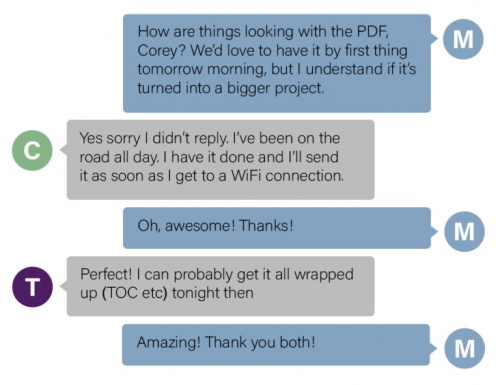Writing for Business Success/Business writing in action/Team-focused messages
A contemporary trend in business is to organise staff members who work closely together into 'teams'. This is believed to lead to greater productivity, and means that team-building and team-focused messages are more important than ever. Here, we'll explore:
- how team-focused messages can be crafted to be most effective, and
- what methods can be used to allow teams to communicate across locations.
Contents
Why is team communication important?
Before we can understand the purpose and use of team-building communication, we should start with a discussion of the importance of collaborative teams in today’s workplace.
There are multiple benefits of people working together in teams versus individuals working independently. First, there is often an increase in creativity, due to the sharing of different ideas, experiences and expertise. Every employee brings a certain body of skills and knowledge to the group. Shared knowledge and complementary skills are strong tools when handling complex projects and assignments. The more a team talks about a project, the more ideas are generated.
Secondly, we typically see an increase in productivity from collaborative and empowered teams. In the technology industry, for example, high-performing teams are normal in the workplace. Each team works with the business owner to decide exactly what work is committed to be completed in a set amount of time. The team then works together to break down the work into manageable tasks. During that work cycle, the team talks every day about their progress, and work may be moved between team members based on availability and expertise. As the team remains together over several work cycles, there is a measurable increase in the amount of work the team can accomplish.
Other potential benefits of collaborative teams are:[1]
- Teams promote a wider sense of ownership,
- Teams encourage healthy risk-taking, and
- Teams contribute to employee satisfaction and retention.
Given the benefits of collaborative teams in the workplace, the key is how organisations can create the proper environment to foster team creation, collaboration and growth. The right conditions have to exist to encourage trust, camaraderie, and the sharing of experience and expertise. Team-focused communication is one key component in successful teams.
Team-focused communication messages can take a variety of forms including instant messaging (IM), text, chat, email, video, audio, and document sharing. Team-focused messages can be short or long, casual or formal, but they must always be professional. Since teams may be geographically distributed, virtual and/or remote, companies must provide the tools and platforms to promote and facilitate team communication.
Short Team-Focused Message
Since interactivity is key to teamwork, a 'chat' environment is a great team-focused communication platform. Short team messages can be sent such as status updates, meeting requests, notes of appreciation, or an invitation to a social event after work. Giving the team a way to respond as a group can be important, in order to get everyone’s ideas and opinions in the same message thread.
While this whole course has emphasised the importance of editing and proofreading, you can generally be more casual about these matters with group chats; however, clarity, professionalism and respectful behaviour are still essential.
Figure 1 shows three team members commenting on the status of a PDF document.
A short team-focused message can also be in the form of an email, especially for quick file attachment sharing to multiple team members, though this can be done in some team chat platforms as well.
| Example: Short team-focused email sending out meeting notes |
|---|
| To: Jeffrey Penrod
CC: Matt King, Joe Abbott, Mary Thomas Subject: Here are the notes from today’s meeting From: Tom Eastmen Attachment: Meeting Notes 5-2-20.docx
As promised, the notes from today’s session with the customer are attached. Thank you, Tom
Product Manager XYZ Inc. |
H5P Object Parameters
The H5P parameters below will be replaced by the actual H5P object when it's rendered on the WordPress site to which it's been snapshotted.
Team-focused communication is a great vehicle to keep team members informed, ensure projects are moving, and ultimately achieve strong results. Given all of the technology available in the workplace today, it is easier than ever to create and send messages to your colleagues. One warning: be aware and considerate of your teammates’ personal space. If you send an email, don’t text or message them right away to ask if they received your message. Don’t contact your colleagues outside of work-hours or at weekends, unless you have mutually agreed to do so.
Long Team-Focused Message
When considering how to communicate a large amount of information to your team, it is a good idea to step back and consider which channel would be best, not only to send your message but also to allow for your colleagues to comment and interact with the rest of the team. Here is an example of a long message to a technical team sent via email.
| Example: long email to technical team |
|---|
| Hi Team,
I had the opportunity earlier this week to talk to some customers about our primary competitor’s new product. Here are some of the areas where it could be improved, based on the feedback. Many people agree that Product X is easy to use and adopt; however, the problem is you also need to provide access and views for other users and roles across many teams so that the whole organisation can view performance. Product Managers using Product X complain that there is no way for them to manage a single backlog for multiple teams or report back on how the teams are progressing on higher-level initiatives. Product Managers need a lot more than issue tracking to manage the growth and development of a product line. Portfolio Managers involved in setting strategy are limited with Product X on how to represent investment themes in an agile enterprise. They need more visibility than just one or two cycles of work. They need more layers, rather than just a stream of customer requests and faults. For Development Managers and Engineering Managers, Product X doesn’t provide them with the ability to do capacity planning. At the root of that is the ability to get a good understanding of their team’s work hours and productivity — something that is not possible if you can’t split projects across multiple cycles. In the Product X world, you have to move the whole project if you can’t finish it in one cycle. As a result, projects can sit for a long time across multiple work-cycles, and the whole concept of productivity and efficiency is lost. With no understanding of a team’s efficiency, productivity improvements and predictability data are lost as well. With no capacity planning across multiple teams — or people split across different teams — managers struggle with their ability to manage people and resources needed to meet their commitments. Program Managers complain that they are “swimming in a sea of user stories” that are not associated with higher-level objectives. There is no concept of a multiple project hierarchy. I will keep you posted when I receive more feedback. Thanks, Ellie |
What can we say about this message? On the one hand, it is long and contains a lot of details. On the other hand, the author has broken it up nicely with headings in bold to make the message easier to read.
Besides using email to send this message, what other means could the author use to inform the team in the most interactive way? Certainly short message forms like IM, text, and chat would not be appropriate for this volume of information.
A report, blog post, podcast or document-sharing repository could handle the amount of information, but each would have some drawbacks. Reports are good for large amounts of data, but are not interactive in nature. Podcasts would also be good for the first viewing, but they are static, and the information is not searchable. A blog post could be a good solution, because it could become a 'living' document with team members adding more information about the competitor’s product as it becomes available. The drawbacks of using a blog post in this scenario would be managing hundreds of blog posts being used for multiple topics, as well as quickly finding the post you want on the corporate site. The same drawbacks could also apply with standard document-sharing technology when you have hundreds or thousands of emails or documents to handle.
The best way to send and manage long, team-focused messages could be to take advantage of a team collaboration software platform. These applications help teams access related information — whether it is received as an IM, chat, email, report, or podcast — organised by topic or subject category. They may also allow feedback from team members, who can add new content and/or comment on existing material. This is a rapidly developing area of technology, with new functions being added all the time, and new providers emerging onto the market. In 2020, open source collaboration software tools include Mattermost, Zulip, Riot, Matrix, and Rocket.chat; proprietary software examples include Microsoft Teams, Slack, Flowdock, and Workplace.
Acknowledgements
The content on this page was adapted from Team-focused messages, authored by Robert Danielson and provided by Lumen Learning under a CC-BY-4.0 licence. The content is part of the online course Business communication skills for managers.

